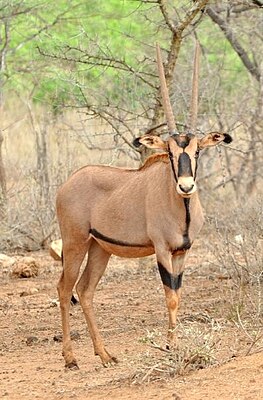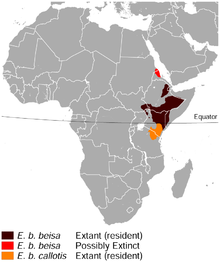Tuft-eared oryx
| Tuft-eared oryx | ||||||||||||
|---|---|---|---|---|---|---|---|---|---|---|---|---|

Tufted ear oryx ( Oryx callotis ), the tufts of hair that give it its name are easily recognizable on the ears |
||||||||||||
| Systematics | ||||||||||||
|
||||||||||||
| Scientific name | ||||||||||||
| Oryx callotis | ||||||||||||
| Thomas , 1892 |
The tufted ear oryx ( Oryx callotis , Syn .: Oryx beisa ssp. Callotis ), occasionally also fringed-ear oryx , is an antelope belonging to the genus of the oryx antelopes .
Etymology and history of research
The tuft-eared oryx was first described as Oryx callotis by Oldfield Thomas in 1892 . The species name refers to the characteristic tufts of hair on the ears and is derived from the ancient Greek καλός ( kalós ), "beautiful", and οὖς ( oûs ), "ear". It can be translated as "nice-eared". In 1908 Richard Lydekker rated the tuft-eared oryx as a subspecies of the Beisa oryx ( Oryx beisa ssp. Callotis ), an assignment that is still, at least partially, recognized today. Later analyzes indicate, however, that the assignment to an independent species ( Oryx callotis ) is justified.
features
The tufted ear oryx differs from other oryx species in particular by its pointed ears with the characteristic, eponymous tuft of black hair up to 7 cm long. All other Oryx species have rounded ears without a corresponding tuft of hair. The horns are long and straight and not curved back and down. The color of the fur is similar to that of Oryx beisa , but the black face markings extend further down to the neck and the black flank band is slightly narrower than that of Oryx beisa .
The tufted ear oryx reaches a shoulder height of up to 120 cm and a head-torso length of up to 170 cm. The tail length is 45-50 cm. Adult bucks reach a body mass of 167–209 kg; the females are slightly lighter at 116–188 kg. The horns reach a length of up to 80 cm and tend to be a little longer in the females, but also thinner than in the bucks.
distribution
The distribution area of the tuft-eared oryx extends in East Africa from southeast Kenya to northeast Tanzania . It prefers grassland and scrubland or tree savannahs with an average annual rainfall of 400–800 mm.
Way of life
The tuft-eared oryx lives nomadically in small herds. The size of the area is up to 400 km². It is a herbivore and feeds mainly (> 80%) on grasses. Especially when there is a lack of drinking water, the diet is supplemented with succulents and water-rich tubers, which are scratched free with the front hooves. The animals can survive for up to a month without having to drink.
Reproduction
Sexual maturity is reached between 18–24 months of age. The females usually give birth to a single cub per year. The gestation period is 8.5–9 months. The pregnant female leaves the herd for birth and returns to the herd with the newborn after 3-4 weeks.
The animals can live up to 21 years in captivity.
Domestication attempts
In the early 1970s, attempts to domesticate the tufted-eared oryx were made at Galana Ranch in southeastern Kenya. Over 150 animals were caught and kept in an outdoor enclosure on the ranch. The animals also reproduced without any problems in captivity. The costs for additional feed, water and veterinary care were lower than for a herd of comparable size, but the workload for the shepherds was considerably greater. After a ban on the commercial use of wild animals came into force in Kenya in 1977, all attempts at domestication were stopped.
Danger
The IUCN lists the tuft-eared oryx as a subspecies of the Beisa oryx ( Oryx beisa ssp. Callotis ) and classifies it as “vulnerable”.
Individual evidence
- ↑ a b c d e f g h D. N. Lee, RW Dolman & DM Leslie Jr .: Oryx callotis (Artiodactyla: Bovidae) . In: Mammalian Species , Vol. 45., No. 897, pp. 1–11, 2013. (pdf) ( Page no longer available , search in web archives ) Info: The link was automatically marked as defective. Please check the link according to the instructions and then remove this notice.
- ^ R. Lydekker: The Game Animals of Africa . P. 285, Rowland Ward Ltd., London, 1908. (digitized version)
- ^ CP Groves: Genus Oryx . In: DE Wilson & RA Mittermeier (eds.): Handbook of the mammals of the world . Vol. 2 Hoofed mammals , pp. 688-692, Lynx Edicions, Barcelona, 2011.
- ^ IUCN SSC Antelope Specialist Group. 2008. Oryx beisa ssp. callotis. The IUCN Red List of Threatened Species 2008. doi : 10.2305 / IUCN.UK.2008.RLTS.T15572A4830402.en .

